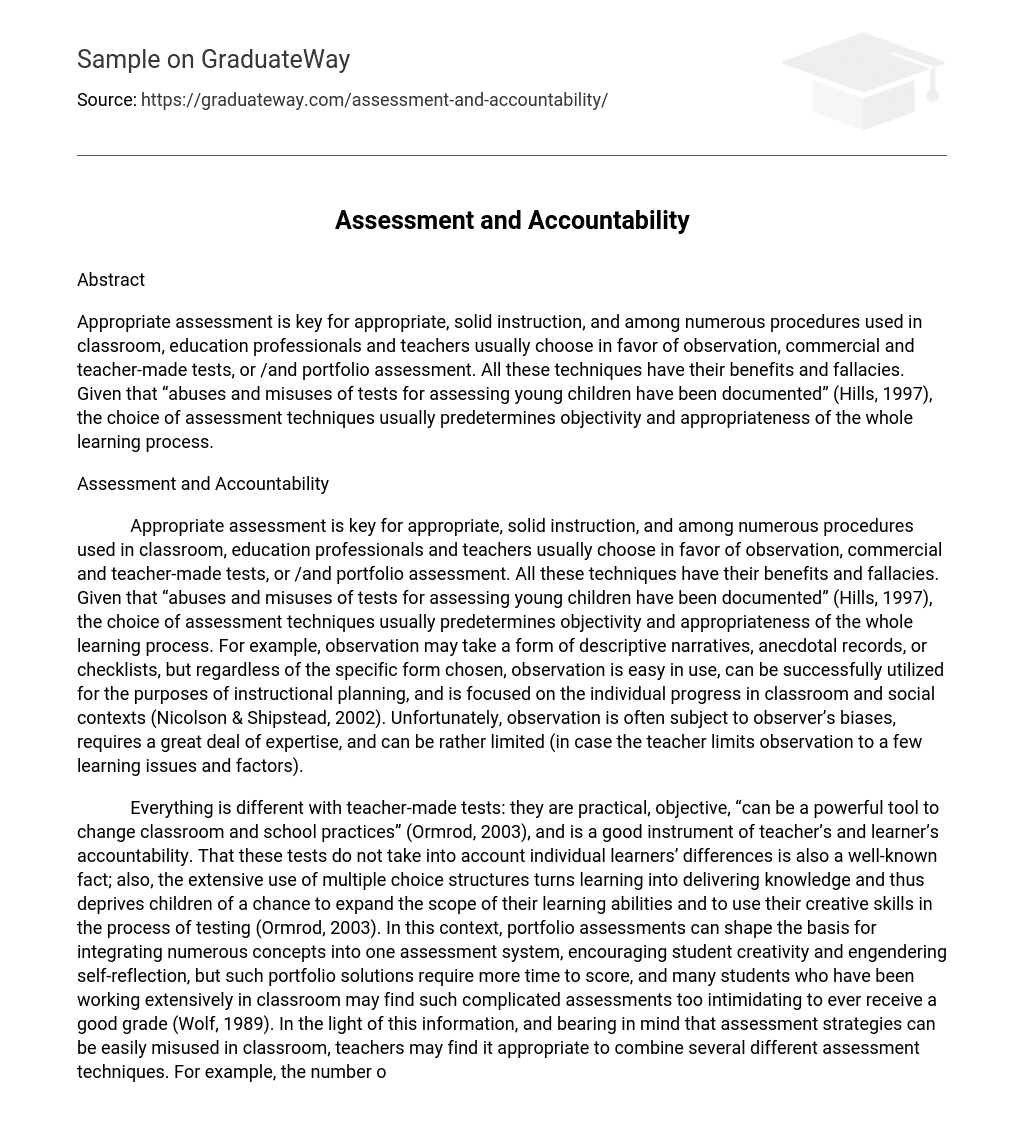Abstract
Appropriate assessment is key for appropriate, solid instruction, and among numerous procedures used in classroom, education professionals and teachers usually choose in favor of observation, commercial and teacher-made tests, or /and portfolio assessment. All these techniques have their benefits and fallacies. Given that “abuses and misuses of tests for assessing young children have been documented” (Hills, 1997), the choice of assessment techniques usually predetermines objectivity and appropriateness of the whole learning process.
Assessment and Accountability
Appropriate assessment is key for appropriate, solid instruction, and among numerous procedures used in classroom, education professionals and teachers usually choose in favor of observation, commercial and teacher-made tests, or /and portfolio assessment. All these techniques have their benefits and fallacies. Given that “abuses and misuses of tests for assessing young children have been documented” (Hills, 1997), the choice of assessment techniques usually predetermines objectivity and appropriateness of the whole learning process. For example, observation may take a form of descriptive narratives, anecdotal records, or checklists, but regardless of the specific form chosen, observation is easy in use, can be successfully utilized for the purposes of instructional planning, and is focused on the individual progress in classroom and social contexts (Nicolson & Shipstead, 2002). Unfortunately, observation is often subject to observer’s biases, requires a great deal of expertise, and can be rather limited (in case the teacher limits observation to a few learning issues and factors).
Everything is different with teacher-made tests: they are practical, objective, “can be a powerful tool to change classroom and school practices” (Ormrod, 2003), and is a good instrument of teacher’s and learner’s accountability. That these tests do not take into account individual learners’ differences is also a well-known fact; also, the extensive use of multiple choice structures turns learning into delivering knowledge and thus deprives children of a chance to expand the scope of their learning abilities and to use their creative skills in the process of testing (Ormrod, 2003). In this context, portfolio assessments can shape the basis for integrating numerous concepts into one assessment system, encouraging student creativity and engendering self-reflection, but such portfolio solutions require more time to score, and many students who have been working extensively in classroom may find such complicated assessments too intimidating to ever receive a good grade (Wolf, 1989). In the light of this information, and bearing in mind that assessment strategies can be easily misused in classroom, teachers may find it appropriate to combine several different assessment techniques. For example, the number of teacher-based tests should be reduced to minimum, while a reasonable combination of portfolios and observations may serve a reliable source of grading and scoring students at the end of the learning unit. Portfolios should be designed in a way that does not distort but on the contrary, facilitates students’ memorizing and recalling, while observations should cover a broad range of learning initiatives and progress factors in classroom. Teacher-made tests can be used on occasional basis for brief evaluation of the student progress at some stages of learning.
References
Hills, T. (1997). Critical issue: Assessing young children’s progress appropriately. North
Central Regional Educational Laboratory. Retrieved July 16, 2009 from http://www.ncrel.org/sdrs/areas/issues/students/earlycld/ea500.htm
Nicolson, S. & Shipstead, S.G. (2002). Through the looking glass: Observations in the early
childhood classroom, 3rd ed. Upper Saddle River, NJ: Prentice Hall.
Ormrod, J.E. (2003). Educational psychology: Developing learners. Columbus: Merrill
Prentice Hall.
Wolf, D. (1989). Portfolio assessment: Sampling student work. Educational Leadership, 46
(7): 35-37.





